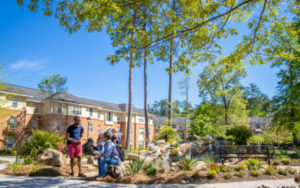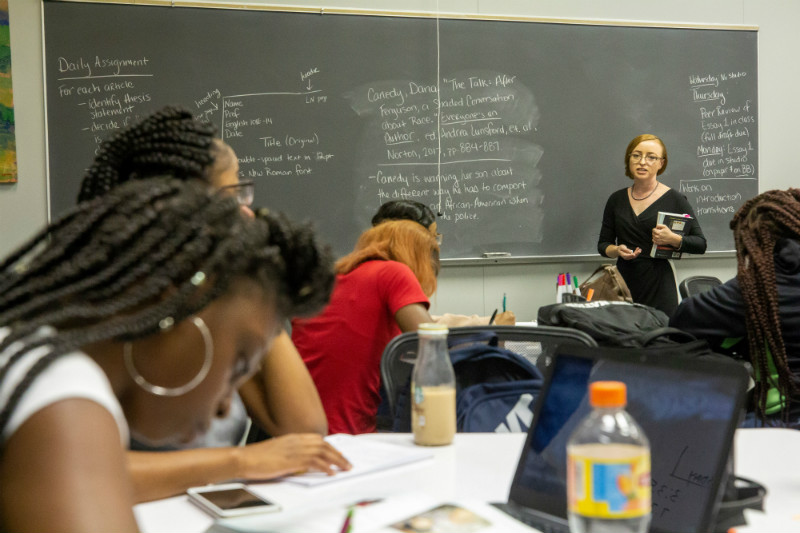By Andy Brack, editor and publisher | Millions of American students attending college for a classic liberal arts education don’t sit around watching MSNBC, attending Democratic Party meetings or reading The New York Times.
 Unfortunately, the word “liberal” in the three-word educational phrase has morphed into a pejorative term, often leading to misunderstandings for what’s intended to describe a broad-based education that expands how students understand and relate to the world.
Unfortunately, the word “liberal” in the three-word educational phrase has morphed into a pejorative term, often leading to misunderstandings for what’s intended to describe a broad-based education that expands how students understand and relate to the world.
“The word ‘liberal’ has become a political lightning rod, but a liberal arts education has nothing to do with left-leaning politics,” said Gibbs Knotts, interim dean of the School of Humanities and Social Sciences at the College of Charleston. “A liberal arts education prepares students to be better communicators, both orally and in writing. It exposes students to a wide range of disciplines in the humanities and social sciences, as well as in the arts and natural sciences.”
Winthrop University President Dan Mahony concurred, noting liberal arts education has nothing to do with being politically liberal or encouraging students to be more liberal politically.
“I would define a liberal arts education as one that is well-rounded and provides students with knowledge and skills across a variety of areas,” he said. “At its core, it focuses on developing a number of important skills including oral and written communication skills, problem solving skills, critical thinking skills, numerical skills, and many others.”
Mahony said he was a good example of why a well-rounded education was important. Throughout college, he trained as an accountant. After college, he lasted as an accountant for 13 months.
“I found the liberal arts aspect of my undergraduate education to be particularly useful to me as I moved through about three other careers and I appreciated that my institution required me to take a lot of liberal arts courses, including seven English courses — a lot for most accounting majors.”
 Colleges and universities often offer two tracks – the broad curriculum of study highlighted by Knotts and Mahony and more specific study of a professional discipline to develop a deep competency in a skill, such as engineering, But even undergraduate students who focus on courses to get into medical or law school generally are required to take broader courses in English, social sciences and math to ensure they get more of a well-rounded, or liberal arts, education.
Colleges and universities often offer two tracks – the broad curriculum of study highlighted by Knotts and Mahony and more specific study of a professional discipline to develop a deep competency in a skill, such as engineering, But even undergraduate students who focus on courses to get into medical or law school generally are required to take broader courses in English, social sciences and math to ensure they get more of a well-rounded, or liberal arts, education.
“A liberal arts education accommodates a curriculum which encompasses the arts, the natural and social sciences, humanities, philosophy, religion, literature, and languages,” said Francis Marion University President Fred Carter. “Of course, the finest liberal arts education doesn’t simply promote a curriculum, it inspires the independent and lifelong exploration of the knowledge it inspires.”
And Carter should know. He’s not the stereotype of a politically liberal college president. In fact, he served as a major policy adviser for GOP Gov. Carroll Campbell and chief of staff to GOP Gov. Mark Sanford. In between, he ran the old State Budget and Control Board during the tenure of Campbell and another Republican governor, David Beasley.
A broad, deep, liberal arts education, he says, helps political conservatives as well as those who are more liberal.
“Why would anyone even choose an ideology without a full understanding of the range of options and their implications for living a thoughtful and satisfying life?” he asked rhetorically. “And how could one possibly defend opinions without understanding the underpinnings upon which they’re built?”
For those in the education field, there’s not really an accepted synonym for the “liberal” part of the term “liberal arts education,” noted Mike Lefever, interim president and executive director of the state Commission on Higher Education.
“We don’t really say an ‘expansive arts’ or ‘comprehensive arts’ or ‘broad-based arts education,’” Lefever said. “If there is an alternative, talking generally about the benefits of arts and sciences may appeal to some, but there is always the need to define what exactly is ‘arts.’
“You would think that the really smart folks in the academy would have figured this out.”
So when we consider liberal arts education in a society where everything is more polarized, let’s remember we’re talking about educating students to think broadly and consider alternatives, not join a political party.
Andy Brack’s new book, “We Can Do Better, South Carolina,” is now available for $14.99 in paperback via Amazon.
- Have a comment? Send to: editor@charlestoncurrents.com




 We Can Do Better, South Carolina!
We Can Do Better, South Carolina!
























